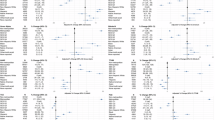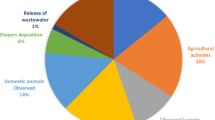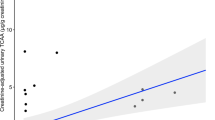Abstract
The objective of this study was to provide evidence to evaluate the proposed National Children’s Study (NCS) protocol for household water sampling in rural study areas. Day-to-day variability in total trihalomethane (TTHM) concentrations in community water supplies (CWS) in rural areas was determined, and the correlation between TTHM concentrations from household taps and CWS monitoring reports was evaluated. Daily water samples were collected from 7 households serviced by 7 different CWS for 15 days. Coefficients of variation for TTHM concentration over 15 days ranged from 8% to 20% depending on the household. Correlations were tested between TTHM household concentrations and the closest date- and location-matched CWS monitoring reports for the 15-day mean (R=0.85, P<0.01). To simulate the NCS-proposed protocol, correlations were tested for 30 additional NCS household samples (polynomial fit: R=0.74, P=0.04). CWS reported TTHM concentrations >50 μg/l corresponded to measured NCS household concentrations ranging from 2 to 60 μg/l. TTHM concentrations were higher in CWS than NCS samples (11.2±3.2 μg/l, mean difference±SE, P<0.01). These results show that in rural areas there is high variability within households and poor correlation at higher concentrations, suggesting that TTHM concentrations from CWS monitoring reports are not an accurate measure of exposure in the household.
This is a preview of subscription content, access via your institution
Access options
Subscribe to this journal
Receive 6 print issues and online access
$259.00 per year
only $43.17 per issue
Buy this article
- Purchase on SpringerLink
- Instant access to full article PDF
Prices may be subject to local taxes which are calculated during checkout



Similar content being viewed by others
References
Wright JM, Schwartz J, Dockery DW . The effect of disinfection by-products and mutagenic activity on birth weight and gestational duration. Environ Health Perspect 2004; 112 (8): 920–925.
Complying with the Stage 2 Disinfectant and Disinfection Byproducts Rule: Small Entity Compliance Guide. http://www.epa.gov/ogwdw/disinfection/stage2/pdfs/guide_st2_stepguide_smallentitycomplianceguide.pdf. 2007, p 21.
Environmental Protection Agency. Water: Stage 2 DBP Rule. http://water.epa.gov/lawsregs/rulesregs/sdwa/stage2/basicinformation.cfm, last updated March 2012.
Bove FJ, Fulcomer MC, Klotz JB, Esmart J, Dufficy EM, Savrin JE . Public drinking water contamination and birth outcomes. Am J Epidemiol 1995; 141 (9): 850–862.
Dodds L, King W, Woolcott C, Pole J . Trihalomethanes in public water supplies and adverse birth outcomes. Epidemiology 1999; 10: 233–237.
Lewis C, Suffet IH, Hoggatt K, Ritz B . Estimated effects of disinfection by-products on preterm birth in a population served by a single water utility. Environ Health Perspect 2007; 115 (2): 290–295.
Savitz D, Andrews K, Pastore L . Drinking water and pregnancy outcome in central North Carolina: source, amount, and trihalomethane levels. Environ Health Perspect 1995; 103 (6): 592–596.
Toledano M, Nieuwenhuijsen M, Best N, Whitaker H, Hambly P, deHoogh C et al. Relation of trihalomethane concentrations in public water supplies to stillbirth and birth weight in three water region in England. Environ Health Perspect 2005; 113: 225–232.
Aggazzotti G, Righi E, Fantuzzi G, Biasotti B, Ravera G, Kanitz S et al. Chlorination by-products (CBPs) in drinking water and adverse pregnancy outcomes in Italy. J Water Health 2004; 4: 233–247.
Dodds L, King W, Allen A, Armson B, Fell D, Nimrod C . Trihalomethanes in public water supplies and risk of stillbirth. Epidemiology 2004; 15: 179–186.
Savitz D, Singer P, Hartmann K, Herring A, Weinberg H, Makarushka C et al. Drinking water disinfection by-products and pregnancy outcome. Final Report for Awwa RF Project no. 2579. American Water Works Association: Denver, CO. 2005.
Grellier J, Bennett J, Patelarou E, Smith RB, Toledano MB, Rushton L et al. Exposure to disinfection by-products, fetal growth, and prematurity: a systematic review and meta-analysis. Epidemiology 2010; 21 (3): 300–313.
Nieuwenhuijsen MJ, Martinez D, Grellier J, Bennett J, Best N, Iszatt N et al. Chlorination disinfection by-products in drinking water and congenital anomalies: review and meta-analyses. Environ Health Perspect 2009; 117 (10): 1486–1493.
Tardiff RG, Carson ML, Ginevan ME . Updated weight of evidence for an association between adverse reproductive and developmental effects and exposure to disinfection by-products. Regul Toxicol Pharm 2006; 45 (2): 185–205.
Legay C, Rodriguez M, Miranda-Moreno L, Serodes J, Levallois P . Multi-level modelling of chlorination by-product presence in drinking water distribution systems for human exposure assessment purposes. Environ Monit Assess 2011; 178: 507–524.
Rodriguez M, Serodes J . Spatial and temporal evolution of trihalomethanes in three water distribution systems. Water Rex 2001; 35 (6): 1572–1586.
Symanski E, Savitz D, Singer P . Assessing spatial fluctuations, temporal variability, and measurement error in estimated levels of disinfection by-products in tap water: implications for exposure assessment. Occup Environ Med 2004; 61: 65–72.
Environmental Protection Agency. Quick guide to drinking water sample collection. http://www2.epa.gov/sites/production/files/documents/samplingprocedures.pdf. 2005, p 5.
Environmental Protection Agency. Comprehensive Disinfectants and Disinfection Byproducts Rules (Stage 1 and Stage 2): Quick Reference Guide. http://www.epa.gov/ogwdw/mdbp/qrg_st1.pdf.
Acknowledgements
We appreciate the contributions of Kristen Malecki and Maureen Durkin from the University of Wisconsin Study Center, Madison, Wisconsin, and Michael Dellarco from NIH/NICHD for assistance in obtaining NCS test results. This analysis was conducted as part of the National Children’s Study, supported in part by the Eunice Kennedy Shriver National Institute of Child Health and Human Development, and funded, through its appropriation, by the Office of the Director of the National Institutes of Health. This project was supported, in part, by NICHD Contract Numbers HHSN275200603416C and HHSN275201100004C, and the Ethel Austin Martin Endowment at South Dakota State University. The views expressed in this article are the responsibility of the authors and do not necessarily represent the position of the National Children’s Study, the National Institutes of Health, or the U.S. Department of Health and Human Services.
Author information
Authors and Affiliations
Corresponding author
Ethics declarations
Competing interests
The authors declare no conflict of interest.
Rights and permissions
About this article
Cite this article
Binkley, T., Thiex, N. & Specker, B. Validation of drinking water disinfection by-product exposure assessment for rural areas in the National Children’s Study. J Expo Sci Environ Epidemiol 25, 303–307 (2015). https://doi.org/10.1038/jes.2014.51
Received:
Revised:
Accepted:
Published:
Issue date:
DOI: https://doi.org/10.1038/jes.2014.51



